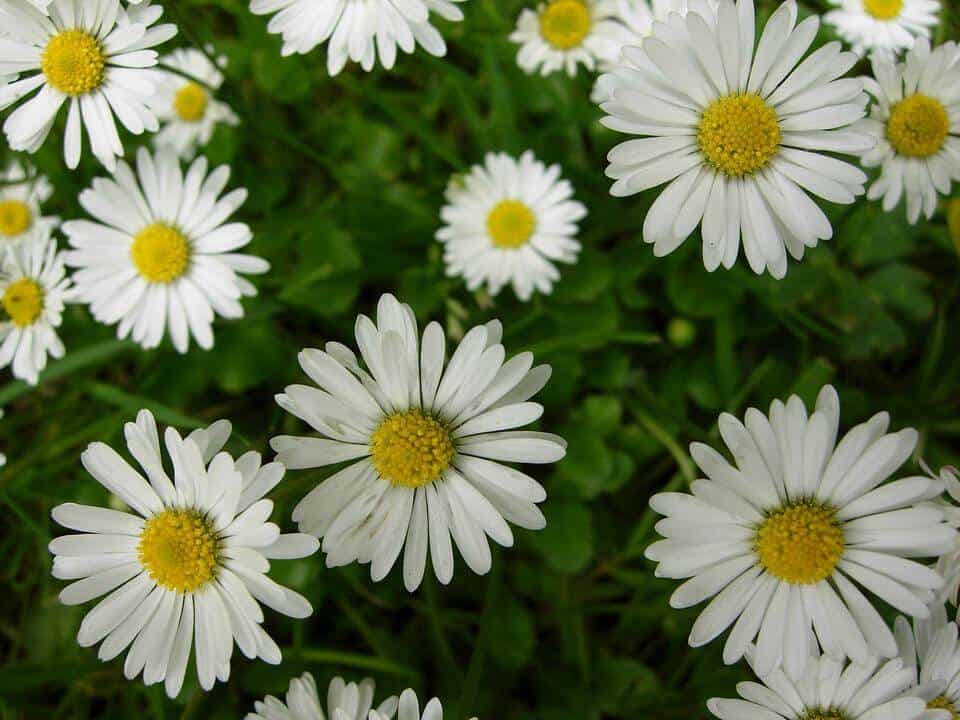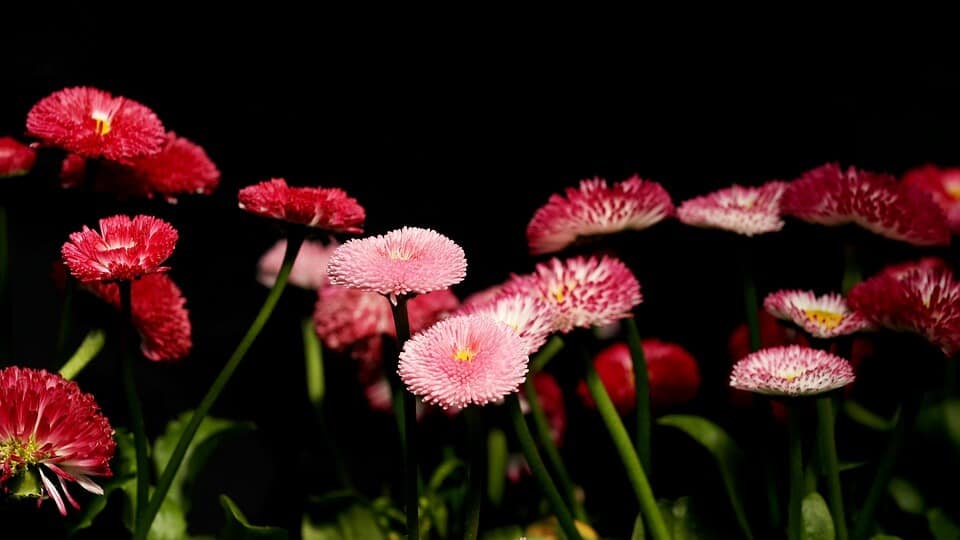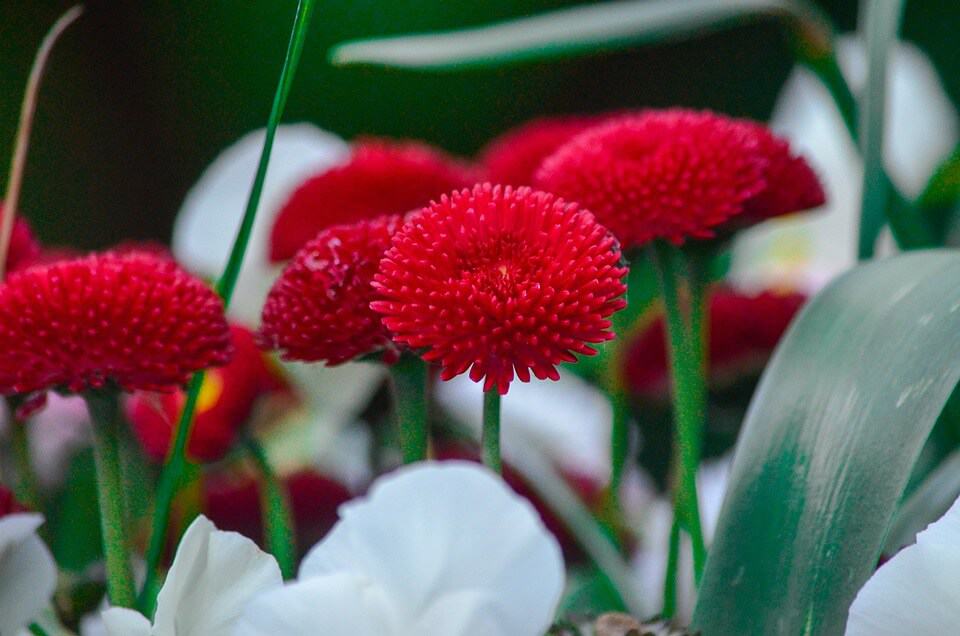Last Updated on January 11, 2023 by a Friendly Gardener
English daisies are pretty and luckily, quite easy to grow too. But if you’re not careful, they can grow like weeds and take over your lawn which is where they get the name ‘lawn daisy’ from.
Just so that doesn’t happen, we put together an English daisy care guide for you.
The English Daisy: A Brief History

The Bellis perennis L, better known as the European daisy, lawn daisy, or English daisy, is a popular plant because of its flowers. They typically have something that looks like a yellow circle in the middle and the petals are red, pink, or white in color. The stems of these flowers are anywhere from three to six inches long.
If you didn’t know it already, the petals of the English daisy flower shut at night and open in the morning when the sun comes up. These flowers, as attractive as they are, are very generous when it comes to reseeding which means they can grow like weeds and not in a good way.
So, there are a few things to know about this plant if you want it to grow like the delight that its flower is.
Three Types of English Daisy Cultivars

For the uninitiated, while there are many different shapes in which the flowers come, the English daisy plant is actually a cultivar and there are three types in that category.
- Galaxy is the one where the center is yellow and it’s a flat rosette. The petals of flowers from this variety can be red, pink, or white.
- Tasso Pink is the second English daisy cultivar which is round in shape. It is also quite compact which means you can expect the flowering stem to grow only as tall as six inches.
- Pomponette is the final one and this is interesting. It has double flowers which have a spherical center and the petals, white, pink, or red, will fold upwards.
Now, let’s look at some of the basics of English daisy care.

Light
If you are in a hotter zone, you might want to bring the daisies indoors to protect them from the afternoon sunlight but otherwise, they will need about four to six hours of sun every day. This will keep their bloom intact and the plant safe and healthy.
Soil
English daisies need rich soil just like a lot of vegetables and roses. They are very tolerant to a lot of pH levels which means the soil can be loamy. If you’re not sure what that is, loamy soil is a mix of clay, silt, and sand.
Water
While they need four to six hours of sun, they also need to be watered regularly because they are not very good at tolerating drought. You need to make sure the soil is moist and cool but the feet of the plants cannot be wet. This is especially for when the weather is already soggy.
Temperature and Humidity
As mentioned before, English daisies do better when the temperature is on the cooler side of things. If the summers where you live are relatively cool, this might be a good choice because the plant has a good shot at blooming all through the season.
Under the right circumstances, it will also propagate very well and has the capacity to create an entire colony. High humidity is also not a problem and neither is a little bit of dampness.
Fertilizer
Now, while it has a lot of capacity for alkaline and acidic soil, if what you have is really poor or rocky, you should get some slow-release fertilizer. Typically, the all-purpose varieties are good enough for an English daisy.
Add the fertilizer at the beginning of spring when they are not feeding heavily. So, they are well placed to absorb as much as they can from the soil.
How to Plant English Daisy Seeds

If you already got your English daisy seeds, here’s the guide to planting them efficiently.
Now, this process takes a bit of time which means those who want to see the flowers soon must try to grow English daisies from mature plants instead of seeds. But otherwise, here’s what you need to do.
- Step 1: Sow the seeds in the fall when the weather is cold which is the perfect time for them to start the process of flowering. Before the last frost of the fall is also the time when they grow leaves quickly and well.
- Step 2: Sow them on the surface of well-draining soil freely and gently press them down with your fingers. Make sure you don’t cover the seeds because they need direct sunlight to start the process of germination.
- Step 3: The process of germination takes about 10-25 days and at this time the soil must be moist. It must also have organic matter. But don’t fertilize it just yet.
How to Care for English Daisies

Whether you are growing your English daisy in pots or on the ground, it should be clear to you by now that these plants grow very easily. But there are a few things you should know if you don’t want to go wrong with growing one of the easiest types of flowers.
These are perennials that thrive in cool temperatures. This means you must protect them from the sunburn of sunny summer afternoons.
This is mostly applicable to the southern type of sun which can not only stop the plant from flowering but can also kill it. So, even though English daisies are perennials, they are often treated like cool-season annual plants or biennials.
If you are growing this plant from a seed, you must start growing it in a cold period like fall as mentioned above. You can plant them outdoors if you live in a place with a mild climate and do so in winter or fall so that they start flowering in the spring.
You want to get soil that is evenly moist and well-drained. This plant is not very tolerant of drought which is why the soil must always be moist. And if you are living through a drought, make sure your English daisy doesn’t feel it by watering the plant constantly.
Wrapping Up
And finally, when the flowers start to fade, you should do some deadheading which is to remove the old flowers. This will give the plant some more time to bloom instead of redirecting its energy towards producing new seeds.


